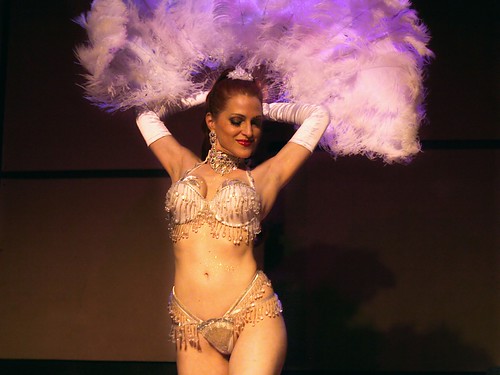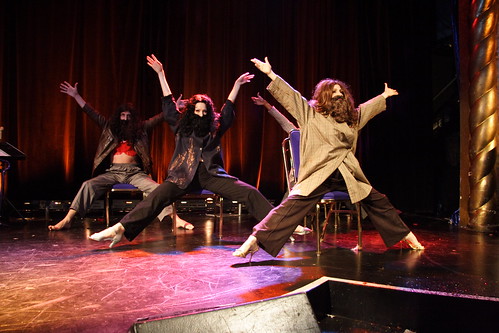42 Versions of Harlem Nocturne
When I interviewed Dixie Evans for this blog, she mentioned how some of the dancers would fight over who got to use the song Harlem Nocturne. In my classes, I talk about overused songs in burlesque, such as Night Train, Lament, and The Stripper (and of course there are many more modern songs that get used repeatedly), and I actually encourage my students to use them. Of course, they might not want to subject some of the most experienced performers in burlesque to them, but if they are new performers, they're bringing in new audiences, and those audiences may have never seen a woman do a fan dance to Harlem Nocturne or a shimmy to Night Train. I also think that since much of this music, such as the material on Striptease Classics, was produced and arranged to accompany sexy showgirl or striptease performance, it's the best to use to learn. Although almost all neo-burlesque performers play with more recent music--I've even choreographed a Fosse-tribute chair dance to Jethro Tull's Aqualung--I believe it can be useful, if not absolutely necessary, to know how something is constructed before you deconstruct it.
Many people whose opinions I respect and often defer to disagree with me on this, but my feelings about it stick with me.

Above: Me doing a white feather fan dance to Harlem Nocturne. Photo by Linus Gelber.

Above: Me leading my troupe, The Belles of the Bowery, through Aqualung at the 2006 New York Burlesque Festival. Troupe members in this photo are Burgundy Brixx and Johnny Porkpie. Photo by Allen Lee.
Musicians often cover tunes by other musicians, and many bands are expected to play standards. In ballet and other formalized dance traditions, performances are often choreographed to music that some audiences expect, and the choreography and staging may be standard, innovative, or even iconoclastic. I think it's fine to treat the standards and classics of burlesque music the same way.
I'm not saying I never get sick of this music, although honestly, as a teacher, I constantly get to see people's eyes light up when they hear it and that usually keeps it fresh for me.
Having heard me muse about this on many occasions, Little Brooklyn just sent me this link:
'This week saw the passing of the great Earle Hagen. His name may not be a household word, but his music is burned into your brain. He was a TV theme writer extraordinaire, whose credits include catchy ditties for The Andy Griffith Show, The Dick Van Dyke Show, That Girl, and The Mod Squad to name a few. A bunch of his themes are available at AM Then FM's Hagen tribute post.
'Hagen is also the composer behind "Harlem Nocturne", probably one of the most covered saxaphone songs in history (500 versions so far and counting). Writen in 1939 while Hagen was an arranger with the Ray Noble Orchestra, the song has lived on as a standard for every big band, bar band, R&B band, and instrumental band since. It is also of course a crime soundtrack staple. '
42 Versions of Harlem Nocturne
I think the most expected music in neo-burlesque often comes from the Ultralounge series, Striptease Classics, and Tease: The Beat of Burlesque. Feel free to post other songs or albums you hear time and again!
Posted by Jo Weldon, Headmistress of The New York School of Burlesque, for burlesquedaily.blogspot.com.
Many people whose opinions I respect and often defer to disagree with me on this, but my feelings about it stick with me.

Above: Me doing a white feather fan dance to Harlem Nocturne. Photo by Linus Gelber.

Above: Me leading my troupe, The Belles of the Bowery, through Aqualung at the 2006 New York Burlesque Festival. Troupe members in this photo are Burgundy Brixx and Johnny Porkpie. Photo by Allen Lee.
Musicians often cover tunes by other musicians, and many bands are expected to play standards. In ballet and other formalized dance traditions, performances are often choreographed to music that some audiences expect, and the choreography and staging may be standard, innovative, or even iconoclastic. I think it's fine to treat the standards and classics of burlesque music the same way.
I'm not saying I never get sick of this music, although honestly, as a teacher, I constantly get to see people's eyes light up when they hear it and that usually keeps it fresh for me.
Having heard me muse about this on many occasions, Little Brooklyn just sent me this link:
'This week saw the passing of the great Earle Hagen. His name may not be a household word, but his music is burned into your brain. He was a TV theme writer extraordinaire, whose credits include catchy ditties for The Andy Griffith Show, The Dick Van Dyke Show, That Girl, and The Mod Squad to name a few. A bunch of his themes are available at AM Then FM's Hagen tribute post.
'Hagen is also the composer behind "Harlem Nocturne", probably one of the most covered saxaphone songs in history (500 versions so far and counting). Writen in 1939 while Hagen was an arranger with the Ray Noble Orchestra, the song has lived on as a standard for every big band, bar band, R&B band, and instrumental band since. It is also of course a crime soundtrack staple. '
42 Versions of Harlem Nocturne
I think the most expected music in neo-burlesque often comes from the Ultralounge series, Striptease Classics, and Tease: The Beat of Burlesque. Feel free to post other songs or albums you hear time and again!
Posted by Jo Weldon, Headmistress of The New York School of Burlesque, for burlesquedaily.blogspot.com.


Comments
in 2006 some Australian session musicians did a CD called "Christina Aguilera Sax Tribute" or "Burlesque Tribute to Christina Aguilera". Their version of "Ain't no other Man" will put the shimmy in your shake.Here is a little info about it. http://tinyurl.com/6fcl6g
Tanya Cheex
XO
I think knowing the classics is paying respectful homage to a stylistic and artistic tradition and heritage. That said, I agree with you that you have to know the rules--then break them! I just came back from an "open tease" up here in Seattle and was a little unhappy with ALL of the song choices--not because they weren't "classic" but because the song choices revealed that the girls didn't know much about the art form in which they were participating--and it felt oddly disrespectful (though they clearly had a blast and that's great, too).
I don't mean to sound like a snob or burlesque purist, but the song choice is as imperative as shimmying and slow tease, at least in my book.
Dancing to an old familiar isn't just good for the newbies, it can be good practice for the more experienced performers too. And yes, I agree that these songs are good tools for teaching classes. (Aside: I can't tell you how much I've heard "See You Later, Alligator" from when I took lindy hop classes so many years ago. But it was definitely good for me then, to be able to anticipate breaks, repeats, etc...) As a producer, however, I certainly wouldn't bill repeats of the same old song in the same night/weekend.